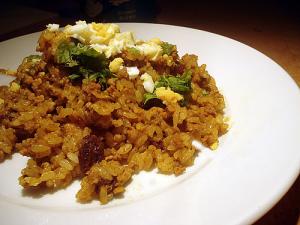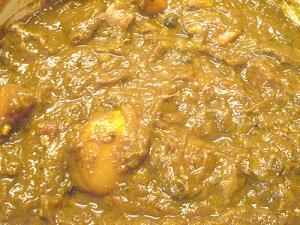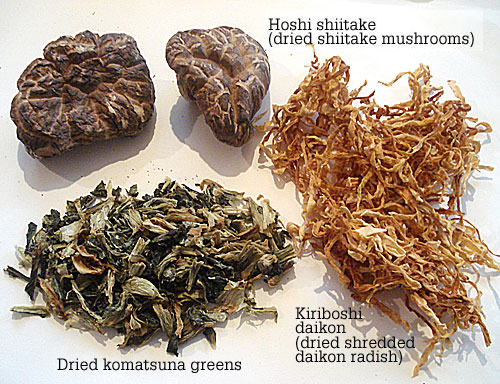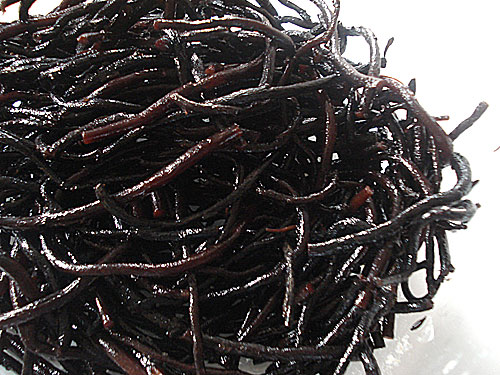
While the standard curry dish in Japan is a kind of curry stew served on plain rice, dry curry, which is a sort of fried rice with curry flavor, is almost as popular. And unlike the stew-type of Curry Rice it's very fast and easy to put together.
What makes it Japanese really is the use of _japonica_ (medium-grain) rice. Dry curry made with Japanese rice makes a great obento lunch, tasty at room temperature or warmed up in the microwave. The stick-together moist quality of the rice keeps it edible where a dryer stay-apart rice like basmati might taste too dry. Dry curry also has the mixture of sweet and savory, which appears quite a lot in Japanese food, especially the kind that comes from the Kanto (Tokyo-area) region where my family is from.
Filed under:
japanese rice yohshoku ground meat curry meat
As I wrote in the Beef Curry recipe, I don't make my own curry powder. Lomo asked in the comments about the "secret" 15 to 20 spices that make up curry powder. After poking around a bit on Japanese web sites, I came up with this page that describes what goes into S & B curry powders, the most popular brand by far in Japan. It's an official S & B page, so should be accurate, though as you can see the percentage given have a pretty wide range. I guess it's because the actual formulas are 'secret'. In any case it gives a starting point for any experimentation I think.
I've also included a recipe for making garam masala. Note that I make no claims whatsoever that these are authentic mixes for Indian or other curries, but I'm talking here about Japanese curry.
Filed under:
japanese ingredients curry spices

Japanese curry belongs to the group of typically Japanese foods that have origins in European cuisine, called yohshoku. Curry is tremendously popular in Japan - it's on the menu at just about every 'family' restaurant and department store restaurants, and there are curry-only restaurants as well as ones that specialize in high class yohshoku in general.
Japanese curry, called curry rice (or kareh raisu) since it's always served with rice, is not much like the curries from India, Thai or other places with better known curries around the world. The best way to describe it is probably to say it's like a English style stew with curry. (It's not at all like the curries you get in modern Britain, which are firmly in the Indian or Pakistani curry families.)
 If you've ever been to a Japanese grocery store, you've probably seen the blocks or bags of curry base taking up an inordinate amount of shelf space. Competition amongst curry base makers in Japan is fierce. The bases are pretty convenient to use, but these days I use them less and less, since I discovered that making curry properly from scratch is not that much more effort than making curry with a readymade curry base. Commercial curry bases contain things like sugar or corn syrup as ingredients, plus some of them use mystery fats (always check the ingredient lists). I add sweetness just via the vegetables, especially a huge mound of slowly sautéed onions.
If you've ever been to a Japanese grocery store, you've probably seen the blocks or bags of curry base taking up an inordinate amount of shelf space. Competition amongst curry base makers in Japan is fierce. The bases are pretty convenient to use, but these days I use them less and less, since I discovered that making curry properly from scratch is not that much more effort than making curry with a readymade curry base. Commercial curry bases contain things like sugar or corn syrup as ingredients, plus some of them use mystery fats (always check the ingredient lists). I add sweetness just via the vegetables, especially a huge mound of slowly sautéed onions.
Either way, to get the most flavorful curry takes a long time. This is definitely a slow-cook meal.
This recipe for beef curry can be adapted to other kinds of meat, or to vegetarian options too. I've included instructions for using a store bought curry base as well as making your own curry roux base.
Filed under:
japanese rice yohshoku favorites beef slowcook curry
In a comment to my Onigiri Revisited post, Jennifer said:
I’ve made fresh onigiri a number of times and would love to be able to make it the night before and take into work with me the next day. How do I do that? (or am I out of luck?) The rice gets all hard and I’ve tried sprinkling water on it in the microwave, but then it falls apart. Suggestions? Do I need a special type of rice? How do I store it after it is made?
Onigiri really are better if made the morning of the day you're going to eat them. I remember my mom waking up very early in the morning to make onigiri when we had a school outing (which usually meant an obento lunch with onigiri).
That being said, you can make them the night before, but you need to take some measures. There are a few things you can do to have moist (but not wet) rice balls.
Filed under:
japanese rice onigiri how-to
I was not going to talk about natto as part of my Odd Japanese food that may help you lose weight(OJFTMHYLW) series this week. But coincidentally, natto as a diet aid has been in the news big time in Japan, with claims that a 'magical' substance in this sticky food helps people to effortlessly lose weight.
Filed under:
japanese lighter weightloss diet ingredients natto legumes

At some time in the past. all our ancestors must have relied on drying as a means of preserving food, especially vegetables. Unfortunately most of these have disappeared from our tables in the West except for grains and legumes. (See note at the end of this article for some exceptions.)
Filed under:
japanese vegetables ingredients mushrooms

Next up in the OJFTMHYLW list is seaweed. But..why not call it sea vegetables? Weed sounds so unappetizing, so unwanted. Yet, seaweed is a terrific food.
Filed under:
japanese lighter weightloss ingredients seaweed
I have always meant to post about this but haven't gotten around to it. This is not an in-depth report with pictures and everything, but just a quick post, since Julie asked :) If you don't live in the Zürich area go ahead and skip to other posts...
Filed under:
japanese swiss shopping zurich
Dieting is just as popular in Japan as it is in other countries, despite the low obesity rates and things there. Fad diets are very prevalent, as are a lot of dubious diet supplements (sapurimento). But if you look at traditional Japanese food, there are a lot of items that are naturally low in calories, carbs and glycemic indeces, high in fiber, and in some cases even have a lot of beneficial nutrients. These items are being looked at anew as weight loss aids in Japan, which is a great thing I think.
Filed under:
japanese lighter weightloss ingredients
Pages